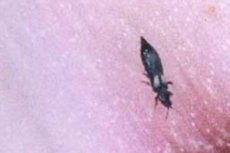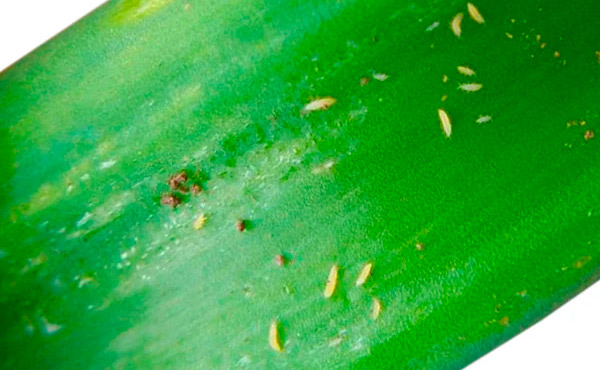Thrips on orchids
Last reviewed: 29.06.2025

Thrips on orchids are among the most common pests that can cause significant damage to your beloved plants. Their presence can weaken orchids, lead to leaf deformation, and reduce flowering quality. In this article, we will discuss what thrips on orchids look like, signs of their presence, and how to fight thrips on orchids using various methods and treatments.
What do thrips on orchids look like?
Thrips are small insects up to 1-2 mm in length. Their bodies are elongated, and their color ranges from light yellow to black. Thrips on orchids (photos) can be hard to distinguish due to their small size and quick movement, but they can usually be seen upon close inspection of leaves and flowers. Thrips often leave behind silver streaks on leaves, which is the result of them feeding on the plant's sap.
Stages of the thrips life cycle
-
Egg Stage:
- Thrips lay eggs inside plant tissues, such as leaves, buds, and flowers.
- The eggs are hidden within plant tissue, making them invisible from the outside.
- The incubation period lasts from 3 to 10 days, depending on temperature and humidity.
-
Larva Stage:
- Newly hatched larvae begin feeding on plant sap immediately.
- They are light-colored, almost transparent, making detection difficult.
- This stage lasts 4 to 7 days, during which the larvae feed actively.
-
Propupa Stage:
- Larvae enter the propupa stage, during which they stop feeding.
- They hide in the soil or orchid substrate.
- This stage lasts about 1 to 2 days.
-
Pupa Stage:
- The pupae continue developing while remaining hidden in the substrate.
- They gradually become more mobile and begin developing wings.
- This stage lasts 2 to 4 days.
-
Adult Stage (Imago):
- Fully developed adults emerge and are ready to reproduce.
- They remain active for 20 to 30 days, feeding on plant sap and laying eggs.
- A single female can lay up to 200 eggs during her lifetime, contributing to rapid population growth.
Duration of the life cycle
The complete thrips life cycle takes 15 to 30 days, depending on environmental conditions. Optimal conditions for thrips reproduction include:
- Temperature: +25…+30°c
- Humidity: 60–80%

Signs of thrips on orchids
Signs of thrips on orchids can vary, but the most characteristic include:
- Silvery streaks or spots on the leaves. This is a primary sign that thrips are feeding on the plant's sap.
- Leaf deformation. Leaves may become crooked, curled, or desiccated.
- Darkening of buds and flowers. Thrips often affect flowers, causing them to wilt or develop unsightly spots.
- Black dots on leaves — these are the excrement of thrips.
In photos of thrips on orchids, you can see what these pests look like and the damage they cause to the plant.
Fighting thrips on orchids
Fighting thrips on orchids requires an integrated approach that includes mechanical removal of pests as well as the use of chemical and biological agents. Here are several effective methods to combat thrips:
1. Mechanical removal
If the number of pests is small, you can try to remove them manually. Wipe the leaves with a damp sponge or cotton pad soaked in soapy water. This will help remove some of the thrips from the plant's surface.
2. Chemical control methods
There are many products available that will help you get rid of thrips. How to treat thrips on orchids? The most popular remedies include:
- Aktara. Aktara for thrips on orchids is a systemic insecticide that effectively destroys thrips. Dissolve the product according to the instructions and water the plant or spray its leaves.
- Fitoverm. Fitoverm for thrips on orchids is a biological insecticide that is safe for plants and humans but lethal for thrips. Treatment should be carried out several times at intervals of 7-10 days.
- Bat rider. Bat rider for thrips on orchids also shows good results in controlling these pests.
3. Biological methods
To combat thrips, you can use their natural enemies — predatory mites or insects that feed on thrips. This method is especially effective in greenhouses, where favorable conditions can be created for the predators.
4. Treating with insecticidal soaps and oils
Insecticidal soaps and oils, such as neem oil or potassium soap, can be used to treat leaves. They form a film that impairs the thrips' breathing and eventually destroys them.
Preventing thrips on orchids
To avoid the appearance of thrips on orchids, it is recommended to follow these preventive measures:
- Regular plant inspections. Check leaves and flowers for signs of pests, such as silver streaks or black dots.
- Isolate new plants. New orchids should be isolated for several weeks to ensure there are no pests before placing them near other plants.
- Maintain high humidity. Thrips prefer dry environments, so maintaining high humidity can reduce the risk of their appearance.
- Prophylactic insecticide treatments. Periodic treatment of plants with biological insecticides will help prevent infestations.
Treating orchids for thrips
If you find thrips on orchids, it is important to start treatment as soon as possible. Here are the main steps for treatment:
- Isolate the infested plant to prevent the spread of thrips to other orchids.
- Remove severely damaged parts of the plant, such as leaves or flowers that cannot be restored.
- Apply an insecticide according to the instructions. Treatment should be repeated several times to destroy all adult thrips and their eggs.
- Repeat the treatment after 7-10 days, as insecticides may not affect the eggs, and new larvae may emerge during this time.
Conclusion
Thrips on orchids can become a serious problem for orchid growers, but with the right approach and timely treatment, they can be successfully controlled. Fighting thrips on orchids includes mechanical removal, the use of chemical and biological agents, as well as preventive measures to prevent re-infestation. Regular plant inspections and maintaining a healthy environment will help your orchids remain beautiful and healthy.
If you notice signs of thrips on orchids, such as silver streaks or black dots on the leaves, do not delay treatment. Use proven insecticides, such as aktara or fitoverm, and follow care recommendations to keep your orchids healthy and blooming abundantly.
